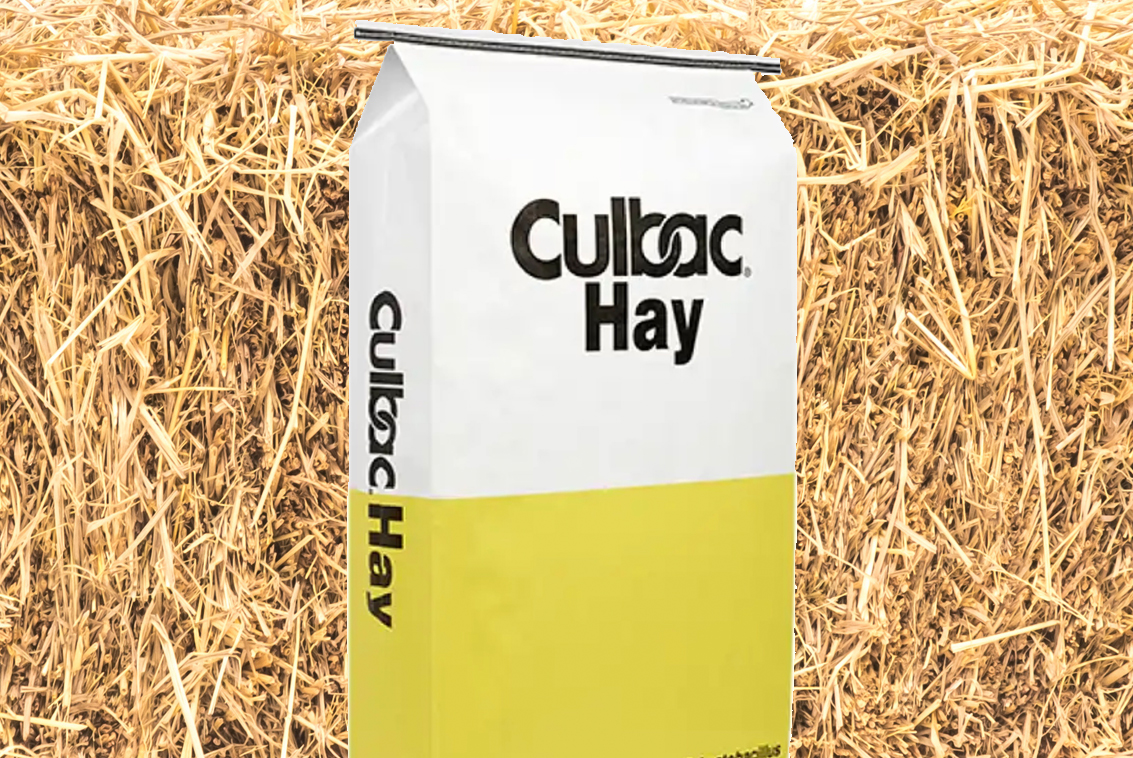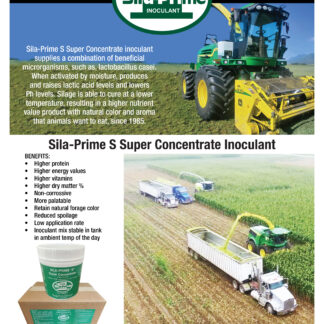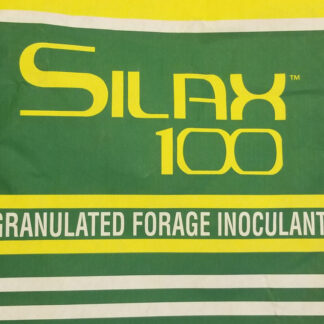Description

 Improving grass hay quality with Culbac® Forage
Improving grass hay quality with Culbac® Forage
High quality grass hay is an important forage component for efficient growth and performance in ruminant and equine diets.
Higher quality grass hay high will reduce protein and energy supplementation costs as well as produce greater animal performance than lower quality grass hay. The quality of grass hay, just like legume hays is dependent on retention of the tender leaves and the absence of mold and heat damage in the bale.
Controlling quality variables
Maturity and leaf loss are two management issues which have a large impact on forage quality. As grass hay dries below 16% moisture, significant leaf loss occurs resulting in lost hay volume and reduced hay quality. In addition, hay texture becomes courser as leaves are lost and the stems dry becoming tough and brittle.
Bale Grass Hay at 16% to 20% moisture
Grass hay baled at 16% to 20% moisture will contain higher crude protein and relative feeding value than hay baled at lower moisture levels. The hay will also have a softer texture and greener color with improved palatability and preference.
Culbac® Forage Treatment can help hay producers produce higher quality hay with more leaves as well as protect hay from spoilage in times of high humidity and slow drying weather.
Leaf retention at baling can be controlled
Leaf tip retention has been shown to have a significant impact on forage quality.
Culbac® Forage Treatment allows hay to be baled at higher moisture, which increases leaf retention. When baled at the recommended moisture level, Culbac® Forage Treatment will allow the production of higher quality hay without spoilage and heat damage.
show more
Application
Culbac® Forage Treatment can be applied at the baler or at the swather or cutter. When applied at the baler, either Culbac® Forage Dry or Culbac® Forge Liquid can be used. When applied at the cutter, a low volume sprayer is used to apply Culbac® Forage Liquid ahead or behind the conditioner.
Additional Benefits of Using Culbac® at the Swather/Cutter vs. Baler
- Stops mold growth earlier
- Improved forage quality after a rain
 Recommended grass baling moisture
Recommended grass baling moisture
As shown in the included graph, the rate of spoilage in hay accelerates at 20%. When the moisture level reaches 30%, spoilage can be very significant and hard to control.
The ideal baling moisture level for grass hay should be between 18% and 22%. This range provides adequate moisture for high leaf retention and but not too high for prevention of spoilage from mold.
 Since weather is unpredictable, and hay making conditions are not always ideal, Culbac® Forage provides an additional margin of safety when rain is imminent or high humidity slows hay drying. Even in worst case conditions, Culbac® Forage can help make the difference to improve the quality of the baled hay.
Since weather is unpredictable, and hay making conditions are not always ideal, Culbac® Forage provides an additional margin of safety when rain is imminent or high humidity slows hay drying. Even in worst case conditions, Culbac® Forage can help make the difference to improve the quality of the baled hay.
Application Rates for Culbac® Forage
Culbac® Forage liquid:
- When hay moisture is below 22%, apply at 2.5 ounces of Culbac® Forage Liquid per ton of hay.
- When hay moisture is above 22% use a double rate of 5.0 ounces. Mix Culbac® Forage liquid with water and apply one quart to one gallon of mix per ton of hay through a low pressure applicator at the cutter, conditioner or baler.
Culbac® Forage Dry:
- When hay moisture is below 22%, apply Culbac® Forage Dry at the rate of 0.4 pounds per ton of hay
- When hay moisture is above 22%, use a double rate of 0.4 pounds per ton of hay. Apply Culbac® Forage Dry through a dry granular applicator at the baler.
Benefits of baling with Culbac® Forage Treatment
- Decreased mold
- Decreased spoilage
- Decreased heat damage
- Decreased weather risk
- Increased harvest yield
- Increased nutritive value
- Improved palatability
- Fewer days to baling
- Noncorrosive – safe to handle
- Economical
show less
Alfalfa hay quality: A vital component of feeding value and profitability
Leaf retention at baling can be controlled
 Leaf retention has been shown to have a significant impact on forage quality (Table 1). Two–thirds of the nutritive value of alfalfa hay is in the leaf material and reduces significantly as leaves are lost during drying.
Leaf retention has been shown to have a significant impact on forage quality (Table 1). Two–thirds of the nutritive value of alfalfa hay is in the leaf material and reduces significantly as leaves are lost during drying.
Culbac® Forage Treatment allows hay to be baled at higher moisture, which increases leaf retention. When baled at the recommended moisture level, Culbac® Forage Treatment will allow the production of higher quality hay without spoilage and heat damage.
Research
Both University and TransAgra International’s own trial work demonstrates that baling alfalfa at higher moisture (18% – 22% moisture) maximizes leaf capture, decreases mold and heat damage, while maximizing alfalfa quality.
New Mexico State University research demonstrated that approximately 30% of the leaf material was lost when baled at 15.0% moisture. Another New Mexico State study found that the most significant protein loss occurred when alfalfa hay dries down from 23% to 13% moisture.
show more
Application
Culbac® Forage Treatment can be applied at the baler or at the swather or cutter. When applied at the baler, either Culbac® Forage Dry or Culbac® Forge Liquid can be used. When applied at the cutter, a low volume sprayer is used to apply Culbac® Forage Liquid ahead or behind the conditioner.
Additional Benefits of Using Culbac® at the Swather/Cutter vs. Baler
- Stops mold growth earlier
- Improved forage quality after a rain
 Recommended alfalfa baling moisture
Recommended alfalfa baling moisture
As shown in the included graph, the rate of spoilage in hay accelerates at 20%. When the moisture level reaches 30%, spoilage can be very significant and hard to control.
The ideal baling moisture level for alfalfa hay should be between 18% and 22%. This range provides adequate moisture for high leaf retention and but not too high for prevention of spoilage from mold.
Since weather is unpredictable, and hay making conditions are not always ideal, Culbac® Forage provides an additional margin of safety when rain is imminent or high humidity slows hay drying. Even in worst case conditions, Culbac® Forage can help make the difference to improve the quality of the baled hay.
Application Rates for Culbac® Forage
Culbac® Forage liquid:
- When hay moisture is below 22%, apply at 2.5 ounces of Culbac® Forage Liquid per ton of hay.
- When hay moisture is above 22% use a double rate of 5.0 ounces. Mix Culbac® Forage liquid with water and apply one quart to one gallon of mix per ton of hay through a low pressure applicator at the cutter, conditioner or baler.
Culbac® Forage Dry:
- When hay moisture is below 22%, apply Culbac® Forage Dry at the rate of 0.4 pounds per ton of hay
- When hay moisture is above 22%, use a double rate of 0.4 pounds per ton of hay. Apply Culbac® Forage Dry through a dry granular applicator at the baler.
 Benefits of baling with Culbac® Forage Treatment
Benefits of baling with Culbac® Forage Treatment
- Decreased mold
- Decreased spoilage
- Decreased heat damage
- Decreased weather risk
- Increased harvest yield
- Increased nutritive value
- Improved palatability
- Fewer days to baling
- Noncorrosive – safe to handle
- Economical
show less
Questions? Contact Us.
- inoculant
- preservative
- hay
- dry hay
- wet hay
- moldy hay
- heated hay
- grass hay
- timothy hay
- oat hay
- alfalfa hay
- lactic acid
- sudangrass hay
- orchardgrass hay
- yeast hay
- silage
- haylage
- organic preservative
- bales (round, small square, large square, hay)


 Recommendations for Reducing Nozzle Plugging
Recommendations for Reducing Nozzle Plugging

